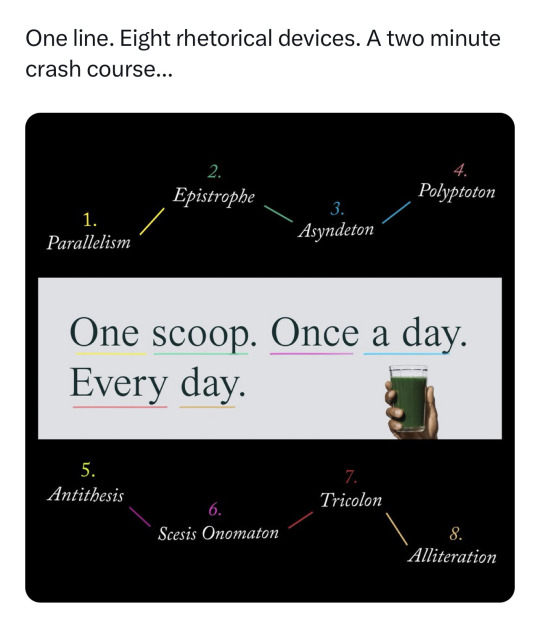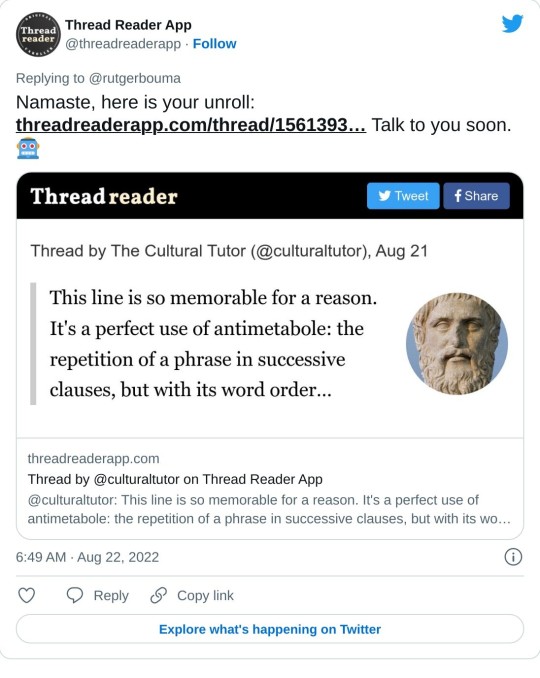#Rhetorical Devices
Note
What are some lesser known rhetorical devices that are surprisingly common in modern literature?
Syngunquity: Use of words you invent yourself. Example: "Syngunquity is the name for the use of words you invent yourself."
Deeznutcequence: Stating a similar sounding preface to an inevitable point. Example: “Have you ever seen an actual Deez?”
Noyomiiem: Reference to a popular internet fad to explain a situation. Example: “This is a man who is never gonna give you up or let you down.”
Just Fucking Lying: Popular in political discourse, you can actually just say shit that isn't true. Example: "Benedict Cumberbatch is not playing Khan."
Haetsynque: If you lack any talent to stay relevant in literature, you can stay famous by inciting hatred of innocent people and rallying useful bigots to your cause. Example: "J.K. Rowling."
Jhatchiipiti: Just have a computer write it for you. Example: "You can have a generative AI program write for you. Having programs writer for you is very programs and valuable, such as both writing, as well as having programming that writes is for you as well."
Hammocry: Hammocks are comfortable and while not traditionally considered a rhetorical device, they're much easier to sleep in. Example: "*zzzzzzzzzzzz zzzzzzzzzzz zzzzzzzzzzz*"
175 notes
·
View notes
Text
apostrophe

So question: is Tumblr's "Your Honor" and Twitch's "Hey, chat" a form of apostrophe? I say yes.
6 notes
·
View notes
Text
was trying to think of an example of synecdoche today and then I remembered this

2 notes
·
View notes
Text
In the speech “I Am Prepared to Die”, Mandela tried to prove how much the ANC was against violent methods of struggle to the last, and how all participants wanted to avoid the use of violence.
“We chose to defy the law. We first broke the law in a way which avoided any recourse to violence; when this form was legislated against, and then the Government resorted to a show of force to crush opposition to its policies, only then did we decide to answer violence with violence.”
3 notes
·
View notes
Text
i genuinely love rhetorical devices and shit so much. as like a kid i was always like ugh this is so annoying but now i read a poem and half of it is repetition and i feel it in my fucking CORE
#let the curtains be blue!!#god damnit#i have miles to go before i sleep#rhetorical devices#repetition#i love it okay#its beautiful#repetition is nothing if not the human experience#it is everything ive ever felt#the entire spectrum of human emotion and then some#im going crazy#im gnawing at the iron bars of my enclosure#this life is a cycle SHoW ME ItS GUTS
0 notes
Text
Power of Repetition in Public Speaking
After watching "Oscar-winning actor & writer Tom Hanks gives the Oxford Union an acting lesson" on YouTube I felt inspired to write this blog. The link below if interested.
youtube
Public speaking is an art that transcends mere words; it involves a deep understanding of human psychology, effective communication techniques, and the strategic use of rhetorical devices. Among these, repetition stands out as a powerful tool that can elevate a speech from ordinary to extraordinary. In this blog, we delve into the Repetition class in speaking, exploring how this technique can captivate audiences, enhance message retention, and leave a lasting impact.
The Basics of Repetition:
Repetition involves the intentional reuse of words, phrases, or ideas within a speech. When employed thoughtfully, it can create emphasis, reinforce key points, and establish a rhythm that resonates with the audience. There are various forms of repetition, each serving a unique purpose:
Anaphora: This involves repeating the same word or phrase at the beginning of successive clauses or sentences. For example, Martin Luther King Jr.'s iconic "I Have a Dream" speech masterfully uses anaphora with the repetition of "I have a dream."
Epistrophe: In contrast to anaphora, epistrophe repeats a word or phrase at the end of successive clauses or sentences. Winston Churchill's famous "We shall fight on the beaches" speech is a classic example of epistrophe in action.
Anadiplosis: This technique involves repeating the last word of one clause or sentence at the beginning of the next. This creates a seamless connection between ideas and builds momentum. Yoda's sage advice, "Fear is the path to the dark side. Fear leads to anger, anger leads to hate, hate leads to suffering," is an example of anadiplosis.
The Impact of Repetition:
Emphasis: Repetition serves as a spotlight, directing the audience's attention to specific words or ideas. By repeating a key point, a speaker can emphasize its importance, making it more likely to be remembered.
Rhythm and Flow: A well-crafted repetition adds a musical quality to a speech, creating a rhythmic flow that engages the audience. This cadence can make the message more memorable and enjoyable.
Connection: Repetition helps to establish connections between different parts of a speech. It ties ideas together, creating a cohesive narrative that is easier for the audience to follow.
Persuasion: Through repetition, a speaker can subtly persuade the audience to adopt a particular viewpoint or take action. The consistent reinforcement of a message can influence attitudes and beliefs.
Practical Tips for Using Repetition Effectively:
Choose Key Points: Identify the core messages you want to convey, and strategically repeat key words or phrases associated with these points.
Consider Your Audience: Tailor your repetition to resonate with your audience. Understanding their preferences, values, and expectations will help you use repetition more effectively.
Vary Your Approach: While repetition is a powerful tool, overusing it can diminish its impact. Vary your repetition techniques to keep the audience engaged and interested.
Practice Pacing: The timing and pacing of repetition are crucial. Practice delivering your speech with the right rhythm to maximize its impact.
In the world of public speaking, the Repetition class is a formidable ally. When wielded with skill and precision, repetition can transform a speech into a compelling, memorable experience for both the speaker and the audience. By understanding the various forms of repetition and practising its implementation, speakers can elevate their communication skills and leave a lasting impression on those who listen.
#Public Speaking#Rhetorical Devices#Repetition Techniques#Speechwriting#Effective Communication#Persuasive Speaking#Anaphora#Epistrophe#Anadiplosis#Key Points#Audience Engagement#Message Retention#Speech Delivery#Communication Skills#Oratory#Eloquence#Presentation Techniques#Audience Connection#Speech Structure#Rhythm and Flow#Tom Hanks#Oxford Union#Acting Lesson#Academy Award Winner#Celebrity Appearance#Hollywood Icon#Acting Techniques#Film Industry#Writing#Performance Skills
0 notes
Text
Spice It Up with Rhetorical Devices
What are Rhetorical Devices?
We all know the literary devices of metaphor and simile. Rhetorical devices are a little different. Instead of comparisons, rhetorical devices are used to add emphasis to one’s words. Most often used in oral speeches, some phrases and sentences are so powerful they go down in history as sayings everyone knows. For example, you have probably heard Julius Caesar’s…

View On WordPress
1 note
·
View note
Text
Take it Home
There is litter in the verges,
there is litter in the hedges,
there is litter in the forests
there is litter on the beaches.
Take your litter home with you,
put it in a bin;
leaving litter everywhere
is an awful sin.
Takeaway wrappers on the kerb,
thrown from passing traffic,
fester with discarded vapes –
it’s almost pornographic.
Take your litter home with you,
put it in a bin;
leaving litter…

View On WordPress
0 notes
Text









Rhetorical devices
1 note
·
View note
Text
China’s economy is currently on the operating table, hunched over by surgeons, chest cavity splayed open, hooked up to a cardiopulmonary machine, surrounded by nurses staring at monitors flashing vital signs. It all looks rather grim.
This surgery, however, is not an emergency bypass. That would be too easy. China has had many of those already – stimulus packages, grand infrastructure projects and many rounds of directed lending.
Every two decades or so, going all the way back to the founding of the PRC in 1949, the surgeons get ambitious. These guys are mad scientists attempting a comic book trope – to create the ultimate superhero.
They want to inject super serum, replace skeletal calcium with adamantium and dose the patient with gamma rays, giving China the powers of shazams out the wazoo.[...]
In the lamented “pre-reform” era, China’s mad scientists engineered spectacular growth by increasing investment from a prewar 6% of GDP to 20% in the first Five-Year Plan, covering 1952-1957. This led industrial output to register a compound annual growth rate.
The Great Leap Forward accelerated this growth to 66% in 1958 and 39% in 1959 before crashing and burning in 1961 when mismanagement of communal farms and “backyard blast furnaces” caught up with the mad scientists.
Course correction starting in 1962 recovered all lost ground by 1965. According to economist Cheng Chu-Yuan, China’s GDP growth averaged 11% between 1952 and 1966, the eve of the Cultural Revolution. (T. C. Liu of Cornell and K. C. Yeh of the Rand Corporation have a lower estimate: 8%.)
More importantly, China built a full kit of infrastructure, machinery and equipment capable of driving future industrialization.[...]
Many analysts have a tabula rasa understanding of China’s reform era, as if there had been no economy before Deng Xiaoping. In reality, China’s industrialization started right after the formation of the PRC with some of the fastest growth recorded in the 1950’s and 1960’s. Even during the “low growth” Cultural Revolution, resources directed towards public health (for example, barefoot doctors) and primary education doubled life expectancy and quadrupled adult literacy by 1980 from pre-PRC levels.
The mad scientists are now at it again. They have about twenty years of new data not just on China but from the rest of the world. When Zhu Rongji was head surgeon, history had ended and markets reigned supreme. This time around, the surgeons are correcting for market irrationality and negative externalities. The next twenty years is again being determined on the operating table.
Three years ago, the surgeons pried open China’s chest cavity with the three red lines credit limits, instantly seizing the speculation driven property sector. Since then, they ripped out unnecessary organs like education companies, clamped the Ant Financial artery and eviscerated the video game industry.
All of this has caused spasms in vital signs from lackluster growth to rising youth unemployment. Wondering whether China will or will not stimulate the economy next quarter or next year is missing the forest from the trees. For the next few years, China’s economy will still be under the knife and whatever adjustments will merely be anesthesiologists and technicians nominally dialing the drugs up and down and adjusting the heart-lung machine to maintain vital signs.
What are these mad scientists trying to achieve? We believe President Xi Jinping’s 2020 target of doubling China’s GDP by 2035 stands. That is an average growth rate of 4.7% for 15 years. But beyond just a numerical target, it is important to figure out what superpowers China is trying to acquire. And just as importantly, what Kryptonite factors China is attempting to inoculate itself against.
China wants America’s Silicon Valley, but regulated; Japan’s car companies, but electrified; Germany’s Mittelstand, but scalable; and Korea’s chaebol conglomerates, but without political capture. It wants to lead the world in science and technology, but without cram schools. A thriving economy, but with common prosperity. Industry, without air pollution. Digital lifestyle, without gaming addiction. Material plenty, without hedonism. Modernity, without its ills. This is, of course, a wish-list and unrealistically ambitious. But these mad scientists sure as hell are going to try. They’ve developed a taste for it.
In college, early into the semester, we went through a ritual called course exchange. Students gathered in an auditorium to swap classes after sampling lectures for three weeks – satisfaction was not guaranteed. The strategy passed down to underclassmen applied to both course exchange and significant others: “Add before you drop.”
China is undergoing – but perhaps botching – the same process with a more party-esque slogan, “Establish the new before abolishing the old.”
The surgeons have been on a tear gutting the old. The big kahuna is, of course, the property sector. But right behind are platform monopolies, private education, financial services and video games. The new has been playing catch-up, with 5G equipment, electric vehicles, photovoltaics and wind turbines being leading examples.
From all appearances, the Industrial Party is in ascendance and China will double down on climbing the manufacturing value chain. The Industrial Party is a political identity that believes industry, science and technology should determine China’s future. Adherents believe that China’s strength lie in the technical skills of her population and thus favor hard-science, high-tech industries as opposed to services and business model innovations.
Therefore, Chinese politicians, whatever their predisposition, must find a way to create space for this next generation of scientists and technicians to develop themselves. They cannot be confined to a production line at a Foxconn plant. Maintaining social stability means finding a use for future scientists and technicians, which means pursuing industrialization. Is there any other way? The key variable for determining the course of China’s future development is thus the massive number of talented technical and scientific workers.
If mistakes were made, it would have been in sequencing and in faith – dropping before adding is a poor strategy in both love and course exchange. China’s mad scientists may have been too confident that electric vehicles and renewable energy would be followed quickly by semiconductors, pharmaceuticals and commercial aircraft.
Perhaps they have reason to be confident. Planning for this surgery has been in the works since 2015 with the Made in China 2025 project. China has been steadily eroding imports of high value added intermediary goods like batteries, precision parts and electrical components, flipping trade with South Korea from deficit to surplus.[...]
China never properly transitioned from its Soviet era Material Product System (MPS) of national accounts to the United Nation’s System of National Accounts (UNSNA) standard, leaving out much of services from reported GDP.
We calculate that China accounts for 22-24% of global GDP and 20-23% of global consumption. We also calculate that household consumption is 50-55% of China’s GDP, in line with global averages. China should easily be able to grow at 4.7% through 2035 with only a modest increase in consumption’s GDP share (5 percentage points over 10 years) without upsetting global economic balances.
In the reform period prior to Xi, everything was sacrificed at the altar of economic growth. In the new era, growth has been walked down from 9.6% in 2011 to an average of 4.7% in the Covid years (2020-2023) as an increasing litany of issues were given precedence. Debt however, soared over this time from 175% of GDP to over 300%. What exactly did all that debt buy?
When Xi assumed leadership of China, he declared that inequality could not be allowed to increase further. Inequality is perhaps the major Kryptonite factor of the American economy which China wasted no time in matching as the economy roared with market reforms.
While still problematic, inequality, as measured by the Gini coefficient, has steadily fallen since 2010 largely as a result of massive investment in urbanization, pushing people into cities and pushing cities up the tiering ladder.[...]
China also poured resources into stamping out last-mile poverty. While most poverty alleviation in China was through economic growth, recalcitrant extremely poverty could only be eradicated by concentrated marshaling of resources, from relocating entire villages to weekly visits by social workers.[...]
Since peaking in 2012, air pollution in Beijing has been cut by over 60%, with Shanghai falling over 50%. China, which used to dominate the list of most polluted cities, now only claims one spot in the top 20. None of this came cheap, from installing scrubbers in smoke stacks to increasing renewables to moving heavy industry to strict emissions regulations for cars.[...]
Before Hu Jintao handed the reins to Xi, Hu warned delegates to the 18th Party Congress in 2012 that “[corruption] could prove fatal to the party… and [cause] the fall of the state.” The popular opinion in the West is that Xi ended China’s highly successful reform era because of an ideological bent. This is off the mark. Xi was brought in to clean house as the wheels were coming off from excesses of the reform era.
Throughout Xi’s decade in office, there has been no letup in his anti-corruption campaign. In 2022, a record 638,000 officials were punished for corruption. While there haven’t been any large scale ideological appeals to the public, it’s a different story within the 98-million-member party.
During this time, free market capitalism and liberal democracies also faced their own existential tests. Success or failure going forward will depend on whether liberal institutions remain intact in the West and whether party discipline can be maintained in China.
What the PRC has had since 1949 is a governing party with the political autonomy to play mad scientist. [...]
Of course we live in the real world, not a comic-book world. The question in the real world has always been whether the economy can be engineered by mad scientists from the top down or is it best left to the invisible hand of the market? [...]
The standard economic opinion – against all evidence – is that China was economically stagnant before Deng’s market reforms. The thinking on this for the American economys is undergoing a transformation in egghead land – just how has neoliberal economics benefitted the American people over the past few decades?
In a Q&A exchange at a conference in Malaysia, Eric Li, the barbed-tongued venture capitalist, was asked, “Do you think top-down directives are sustainable in the long run?”
To which he replied, “It’s the only thing that’s sustainable.… That’s why America is failing today.” After World War II, Li said, the Americans “lost the ability to do top-down design.”
Dec 2023
99 notes
·
View notes
Text
bolas rojas arc is so narratively compelling in terms of the greater qsmp— this was portrayed to be a pvp-based event, an immense contrast from the plot and server we’re used to, and the people winning so far are the most pvp disadvantaged team who are soaring on the power of friendship alone. they are not built for this. they have been spawn-killed repeatedly and they have utterly and entirely lost themselves in gas masks and cannibalism but they have not lost each other. the story prevails the community prevails always has always will
#eleanor.txt#qsmp#team bolas#it’s so very important to me. they’re like a rhetorical device#this is what it’s all about. this is precisely what it’s about#do you hear me. do you get how important it is#(not to say i think they’ll win the purgatory event in general. i think that’s really doubtful actually#but narratively. understand their impact)#qmeta
123 notes
·
View notes
Text
Undoubtedly, Martin Luther King had an innate talent for oratory, but without constant work on himself, without training and developing his abilities, there would not have been that King, whom the whole world knows.
King repeatedly emphasized the importance of getting an education. He took courses in theology every semester for 3 years at the Crozer Theological Seminary.
2 notes
·
View notes
Text


"Isn't it there just for making the right decision?"
#jurgen klopp#liverpool fc#liverpool football club#liverpool fans#lfc#lfcedit#football#premier league#userf#*#not tk#fi's gifs#i do love his little rhetorical device of drawing the interviewer in and getting them to agree w him lmao
34 notes
·
View notes
Text
I do genuinely enjoy pedantry and quibbling and disagreeing with fine-grained details of every sentence ever uttered as any good marxist does, the problem is that tumblr is a horrific platform to nurture that enjoyment on and turns all of us into grand dogmatists where any quibble is a sign of enemy infiltration
#I have two friends I deeply enjoy disagreeing with but there needs to be like a particular trust and intimacy in place first#like some random asshole replying to your post to be a pedant is not a scenario in which you’re having a fruitful discussion#again I think ‘nuance’ as a rhetoric device has a particularly poisonous mainstream applications on social media#where people want to be a devil to the details for either clowning on you or dismissing your entire point#maybe I just need to make a new blog actually lol. this is probably just a symptom of having too many people follow you#but in general like I don’t find social media to be a productive public square of any kind#you’re only going to get that in smaller groups or with people you have a prior established relationship with#I have found random people whose disagreements with me are genuinely productive but that is the exception that proves the norm#in my experience
50 notes
·
View notes
Text

my laptop is on its last fucking legs rn, the cycle is beginning-- the cycle being that every time I start running low on storage with TS4 installed, I usually end up just uninstalling TS4 and all my Mods to free up space (which would be around 90-100 GBs if i were to uninstall both), but like... I'm writing a story, and I still... sort of use TS4, I'm not gonna uninstall it, i just desperately... very desperately need to go through my mods folder and uninstall shit i dont use 😭
#it sucks cuz now im like “oooo... but think of the games I could play... LIKE BALDURS GATE...”#but I cant man I wanna write my story and still be able to go in CAS and make sims and stuff#grgrrrrr i hate storage why did we create the concept of storage on devices </3 (this is a bit of a rhetorical joke question sjhdfdj)#yapping
20 notes
·
View notes
